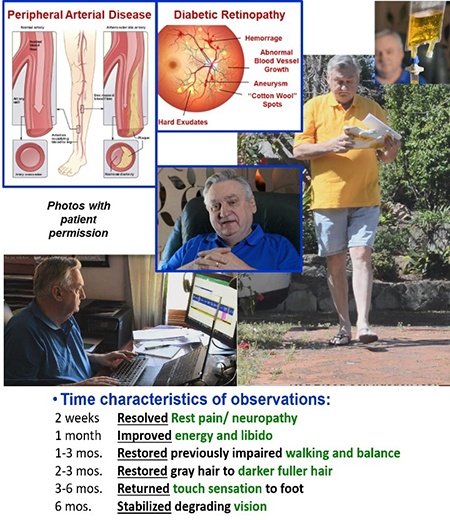RJX Community
Reven, never backward, patient forward.
— Com·mu·ni·ty (noun): a feeling of fellowship with others. Similar: body, society, collective —
Reven has a dedicated mission to serve patients and their loved ones. Amidst these trying times, our collaborations with researchers, doctors, and patients striving to address unmet medical needs, continues to humble us. As an example of RJX community in action, patients with chronic wounds (e.g. Type 1 and Type 2 diabetics) are often burdened by mobility challenges, chronic pain, infection risk (including life threatening sepsis), and as symptoms progress, may undergo amputation. While surgical intervention like stents and amputation might help to stabilize critical limb ischemia patients (CLI), only 46% of them are expected to survive 4 years after diagnosis.1 Affected patients are commonly burdened with pervasive pain, diminishing mobility and social engagement, countless hours in waiting rooms of doctor offices, and scary, life-threatening moments. Further, treating physicians are burdened with a sense of futility in knowing that current medical practice can only do so much. Finally, there is burden on patients’ loved ones, whom witness a steady decline while dutifully providing physical assistance to overcome mobility challenges, wound maintenance, medication tracking, and whom provide transportation and company during appointments.
The quality of patient lives and relationships with their community are affected by the progression of their medical condition. Reven’s hope is that RJX practitioners are able to reduce the number of relationships bearing titles like “helper” and “care-giver” so that titles like “family” and “friends” can be retained, even after the need for care is diagnosed.
 As a patient profile, “PJ” is a Type II diabetic diagnosed with peripheral arterial disease (PAD, which can lead to CLI). Before beginning RJX care under the Australian Therapeutic Goods Administration Special Access process, he was suffering from persistent neuropathic pain, had trouble sleeping, chronic fatigue, and vision degradation from retinopathy. In addition to these challenges, his mobility had diminished to the point that routine movements became daunting, stairs could only be climbed one at a time with rail assistance and walking paths in his home were chosen based on furniture that could be leaned on. While he had yet to battle any chronic wounds, his symptoms matched those of many others who progress to needing chronic care.
As a patient profile, “PJ” is a Type II diabetic diagnosed with peripheral arterial disease (PAD, which can lead to CLI). Before beginning RJX care under the Australian Therapeutic Goods Administration Special Access process, he was suffering from persistent neuropathic pain, had trouble sleeping, chronic fatigue, and vision degradation from retinopathy. In addition to these challenges, his mobility had diminished to the point that routine movements became daunting, stairs could only be climbed one at a time with rail assistance and walking paths in his home were chosen based on furniture that could be leaned on. While he had yet to battle any chronic wounds, his symptoms matched those of many others who progress to needing chronic care.
Over a span of six-months, involving approximately 50 RJX at-home dose administrations, PJ self-reported resolution of his neuropathic pain along with restoration in touch sensation. Additionally, he reported regained strength and coordination to walk up and down stairs confidently again, climb ladders for home projects, and even regained enough dexterity and balance to wear flip-flop sandals at the beach. Alongside these effects he observed darker and thicker hair, restoration of energy and libido, and his eye doctor noted stabilization of his retinopathy. PJ was administered an additional 25 doses of RJX over 3 months before RJX care was put on hold while Reven relocated manufacturing operations to the United States. During this time (11 months), PJ reported that all symptoms remained durably manageable, other than a slight return of grey hair. In the interest of helping more patients and their families to live life to the fullest, PJ’s case motivates us to work tirelessly in our efforts to gain RJX drug approval.
Reference
- Mustapha JA, Katzen BT, Neville RF, et al. Determinants of Long-Term Outcomes and Costs in the Management of Critical Limb Ischemia: A Population-Based Cohort Study. J Am Heart Assoc. 2018;7(16):e009724. doi:10.1161/JAHA.118.009724
